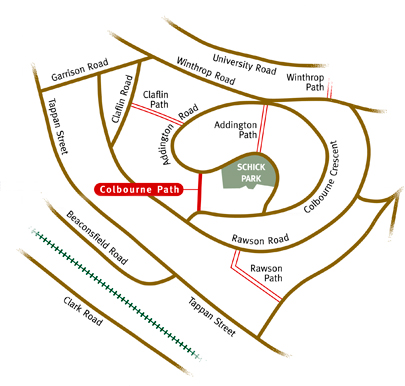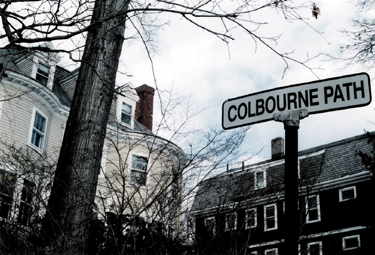
Take a few steps up the unassuming set of concrete steps and your journey has begun. To your left, the iron handrail looks shiny and new, but a bit further up, the old handrail survives, its pockmarked rust declaring longevity. A few years ago, these steps were railroad ties, and the sign marking the path's entrance was of broken cast aluminum. But alas, these features could not endure, and were replaced with more durable, if less aesthetically pleasing, modern equivalents.
Only a little sunlight penetrates the thick canopy formed by the grand old maple trees. The resulting deep shade explains the prevalence of ferns, ivy, and hostas in the plantings along the side of the path. Vertical railroad ties, cut at different lengths, lend a rustic quality to the otherwise functional retaining wall on your right. It's a pleasing combination: the vivid green moss contrasts sharply with the dark wood, while the ivy softens the hard edges. About halfway up the hill, the path crosses an alleyway. Once across the alley, the overhead canopy opens up and we are bathed in sunshine. The sky silhouettes the hilltop's younger trees and rooftops. More hostas and lilies grace the western edge of the path here, backed by a wooden fence. Someone's care and attention to the plantings is evident. There is no sign marking this end of the path.
Aspinwall Hill

Less than 100 feet from Rawson Road, Colbourne Path carries you up the south slope of Aspinwall Hill, depositing you on Addington Road, a hundred feet or so from Schick Park. It achieves this in a mere 230.88 feet, and is the shortest of the seven paths on Aspinwall Hill. There aren't a lot of steps to climb either. They come at the beginning in two sets of eight, and are quickly replaced with a gently rising walkway of concrete squares. A quick check of the topography reveals that this is the less steep side of the hill, while the northeast slope rises dramatically.
F.L. Olmsted's Curved Street Design
We have F.L. Olmsted to thank for the curvy streets that meander up and down Aspinwall Hill. Olmsted's 1883 design included no straight sight lines and plenty of trees. Together, these features lend a country feel to an otherwise densely settled neighborhood. As you proceed along the roadways designed to carry horse drawn carriages, your vantage point shifts between intimate vignettes of homes in their wooded settings and the more expansive views off the hill. But for the pedestrian, a shorter, quicker way up and down was preferable, and on Aspinwall Hill seven paths were included in the overall design. The paths added to the practicality of a home on the hill for those shopping or commuting via Beacon Street.
The Aspinwalls were one of Brookline's oldest families, beginning with Peter Aspinwall who bought land here in 1650. It was his great grandson, Dr. William Aspinwall, who bought 87 acres on the hill in 1788, which he eventually sold to a development company named after the family. It was Thomas Aspinwall, William Aspinwall's eldest son, who was responsible for including the paths in the hill's design in his capacity as a partner in the engineering firm involved in the development. The town accepted Colbourne Path in 1894.